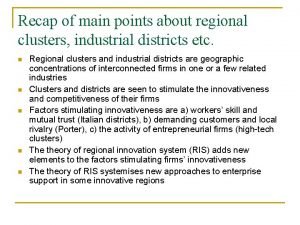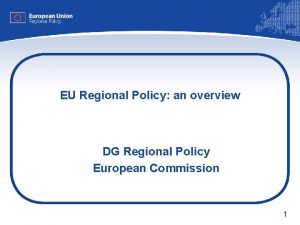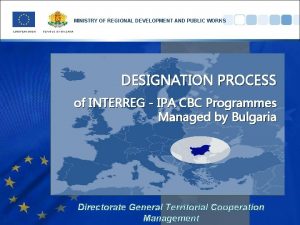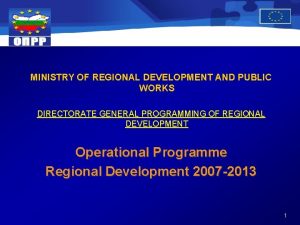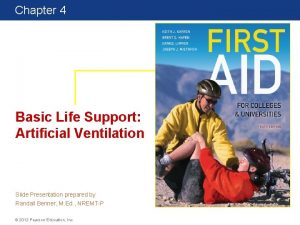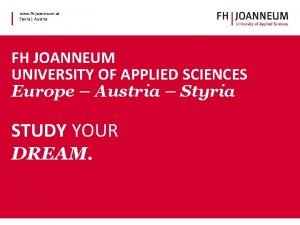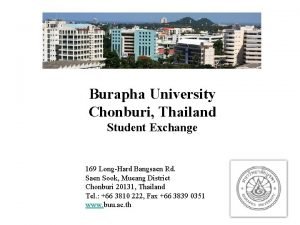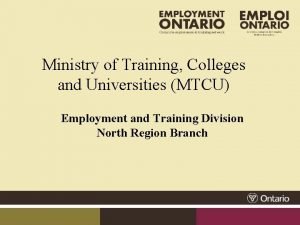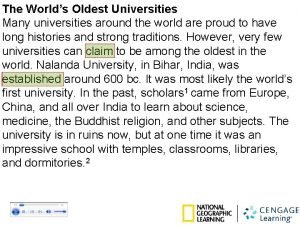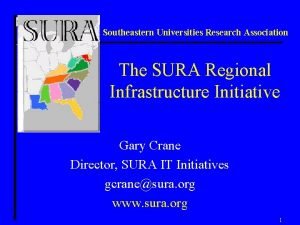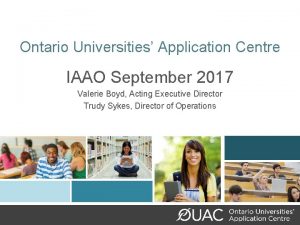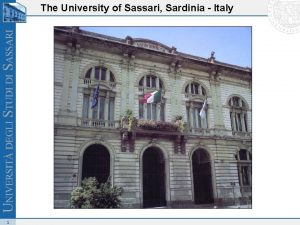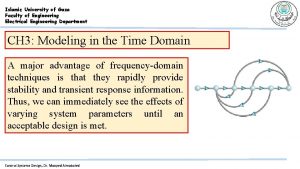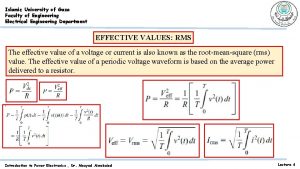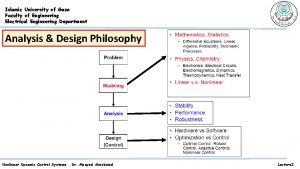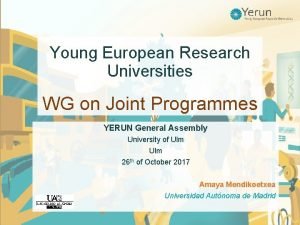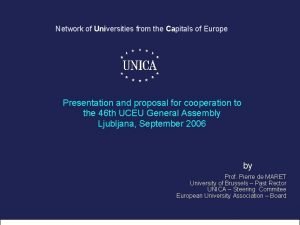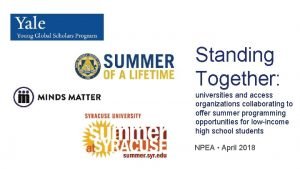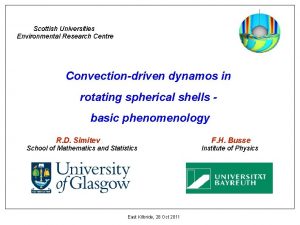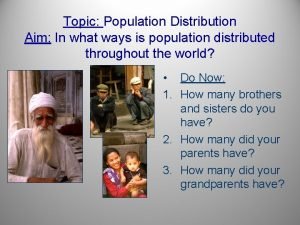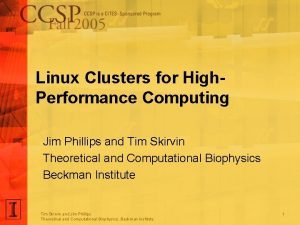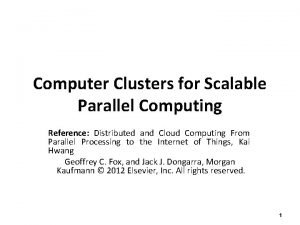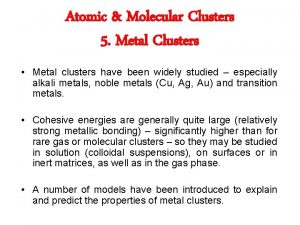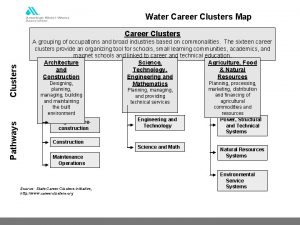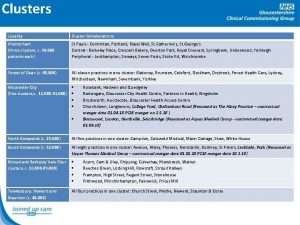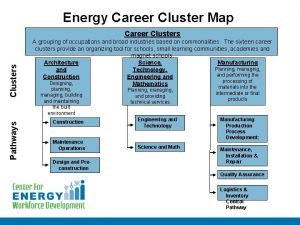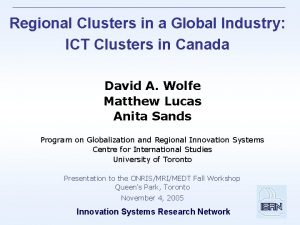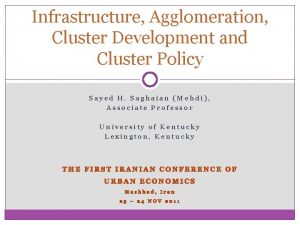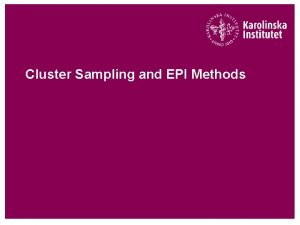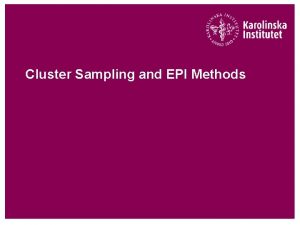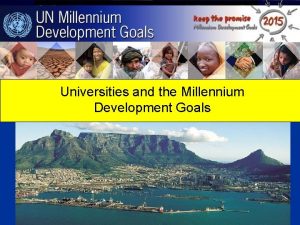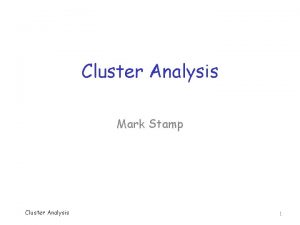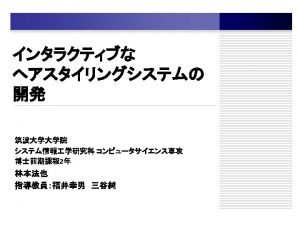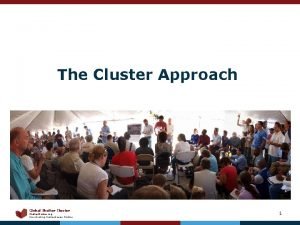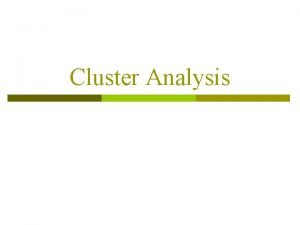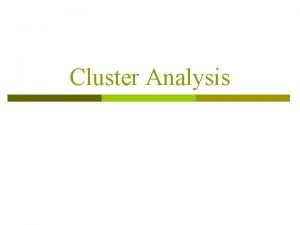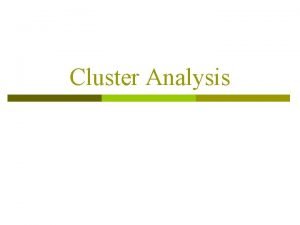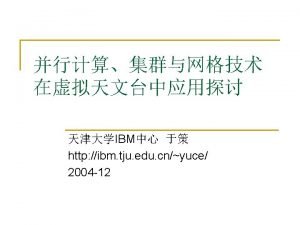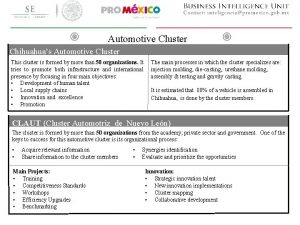Clusters and Cluster Policy Regional Development Universities and



















































- Slides: 51

Clusters and Cluster Policy - Regional Development, Universities and Strategies for Cluster Promotion David Charles CURDS University of Newcastle upon Tyne Business school

Three themes • Defining clusters and cluster policy – Communities of practice and multi-scalar policy • Clusters and higher education – Using clusters to resolve priorities and policy difficulties • Creative industry clusters – Stretching the concept

What do we mean by clusters and clustering? • • • Varied definitions and approaches ‘Clusters’ vs the process of ‘clustering’ Clusters as self-generating groupings Processes of facilitating clusters Importance of linkages and interdependence External economies and un-traded interdependencies • Real phenomena or heuristic devices?

Dimensions and characteristics • • • Multisectoral Interaction/synergy Spatial concentration Hierarchical inter-regional linkages Institutions and identity New forms of governance – frameworks for policy analysis and development

Clusters as innovation systems • OECD Cluster focus group – Innovation seldom takes place in isolation but is systemic. The notion of a cluster as a ‘reduced scale innovation system’ – Clusters are networks of production of strongly interdependent firms linked to each other in a value-adding production chain. – Clusters mostly also encompass strategic alliances with universities, research institutes, knowledge-intensive business services, bridging institutions (brokers, consultants) and customers.

Issues in identifying clusters • Spatial scales – Local – Regional – National • Levels of interaction • Breadth of sectoral coverage • Focus on firms or sectors

Geographical scope and intensity of interaction National Danish small scale clusters Japanese style supply chains Local Pegasus, Argonautics etc Tight interaction Danish megaclusters Finnish Telecoms cluster Motorsport Valley Scottish Enterprise Clusters NOF Flanders Language Valley Silicon Valley Cambridge Biotech Loose agglomeration

Uniqueness • Each country or region has its own unique cluster forms • Variation in selection and variation processes – Between countries/regions – Technologies – Policy systems • No ‘ideal’ cluster or form – no best practice • Cluster ‘innovation styles’

An alternative approach • Cluster as knowledge community • Node of knowledge generation and dissemination • Focus on agglomeration of skilled people rather than firms • Dominant designs, genres and movements • Competition and co-operation • Conventions and institutions • Shared assets

Knowledge community • a knowledge community is ‘a group of people (principally designers, managers, and engineers in this case) often in separate organisations but united by a common set of norms, values and understandings, who help to define the knowledge and production trajectories of the economic sector to which they belong’. (Henry & Pinch, 2000, p 194)

Music cluster/production network Instrument manufacture Instrument retail Session musicians Merchandise manufacture customer Venues Producers merchandise Ticket sales Tour management Logistics Engineers Recording companies Artists Stage Lighting CD manufacture Promotion and distribution Artist management Song writing Sound Studios customer Music publishing Legal

Creative industries cluster? Audience Projects and venues Education and training Associations Local authorities Creative individuals Creative knowledge pool Creative firms Specialist manufacturing support Cultural and creative support agencies Business support agencies Specialist business services Retail

Australia, the Brand - a tourism cluster Clothing Akubra hats Drizabone Literature Films Images Outback life Farming Bushcraft Mateship Food Wine Images Souvenirs Urban lifestyle experience Urban life Architecture and icons Multiculturalism Surfboards and equipment Images Posters calendars T-shirts The country Red Centre Beaches Barrier Reef Rainforest Sport Surfing Sporting excellence Surfware Wildlife Kangaroos Koalas Crocodiles Sea life Birds Indigenous peoples Designs Culture/ stories Animal products Stuffed toy animals Artefacts Didgeridoos Boomerangs Aboriginal designs Music and stories Aussie team sportswear

Scales of policy action • Cluster policies taken up a core element of industrial and innovation policies, but not always labelled as such • National cluster policies – Foresight, Mega-clusters, Cluster as policy tool • Regional clusters – Regional Development Agencies, RIS/RITTS initiatives – Turning sectoral strategies into clusters? • Local clusters/micro clusters – Local authority initiatives – Building on company networking

Cluster development micro/meso interaction Potential Latent Firm Interactions among firms inside and outside regional cluster Shading indicates strength of social infrastructure Working

UK policy on clusters and universities 'The role of our universities in the economy is crucial. They are powerful drivers of innovation and change in science and technology, the arts, humanities, design and other creative disciplines. They produce people with knowledge and skills; they generate new knowledge and import it from diverse sources; and they apply knowledge in a range of environments. They are also the seedbed for new industries, products and services and are at the hub of business networks and industrial clusters of the knowledge economy. ' (DTI/Df. EE, 2001)

Universities and clusters Chance Firm strategy, structure and rivalry Direct assistance to firm management capabilities New business formation Sciencebased discoveries Factor Conditions Demand conditions Provision of skilled labour Research on better exploitation of physical resources Knowledge resources HE as consumer of specialist inputs HE foresight on future demands Related and supporting industries HE projects on supply chain development Spreading knowledge across supply chains Government Advice on policy and regulation Government funding for HE research

University commercialisation strategies • Dilemmas of diversity of knowledge • Need for specialisation in commercialisation • Combining responsiveness and opportunityseeking with focus and business development • Specialist centres and cluster discourses as means to resolve dilemma

Scale of university engagement with clusters • National – national research programmes and centres of excellence • Regional – RDA initiatives with dedicated cluster programmes • Local/micro-clusters – small scale initiatives with local funding or university-initiated • Internal to the university – structures for industrial liaison or research organisation

North East England cases • National – central government initiatives, university innovation centre for nanotechnology • Regional – ONE clusters and centres of excellence • Local/micro-clusters – local initiatives, Digital Media Network • Internal to the university – Newcastle HEROBa. C programme and restructuring

ONE - Strategy for Success • Science and Industry Council • 5 centres of excellence – – – New and renewable energies Life sciences Process industries Digital media Nanotechnology, microsystems and photonics • North. STAR

Funding from ONE, DTI, Do. H etc External Bioscience Firms Links to CELS via Bio. NE 2 t Centre of Excellence Genetics in Life Sciences Knowledge Park Biosci North ICf. L Regional Bioscience Cluster Bio. NE 2 t North. STAR Functional Genomics Platform Academic Bioscience Knowledge/Research Base University Technology Transfer

International Centre for Life


Significance • Universities being enrolled by regional agencies on cluster initiatives at unprecedented scale. Universities also shaping agenda • Universities assembling portfolios of funds for networked support programmes • Regional agencies convinced of importance of universities to clusters. Move to a regionallycoordinated system, but aimed at international excellence • The regional agenda is not necessarily linked with ‘sub-national quality – see US universities

Comparisons with Australia • State level intervention and growing interest at Commonwealth level • Queensland ‘Smart State’ strategy • Prioritisation of growth ‘sectors’ • Biotechnology and ICT, but also advanced mining, ‘new era’ foods • Local level interest in micro-clusters • Universities seeing reduction in proportion of core funding

Queensland support for biotechnology • Bioindustries Taskforce • Establishment of the Institute for Molecular Bioscience (IMB) at the University of Queensland, and attracting key researchers • Establishment of a Centre for Biomolecular Science and Drug Discovery and research commercialisation centre at Griffith University • Bachelor of Biotechnology Innovation degree at QUT • Centre for Immunology and Cancer Research at Princess Alexandra Hospital • Bio. Start initiative to encourage and support start-ups • Bio. Link networking program • Supporting missions to major biotechnology conferences • International biopartnering initiatives • Government-wide mechanism to identify the key priorities for R&D spending

Culture and creative industries in Brisbane • Growing cultural and creative sector • Physical development on riverside – South Bank • Adjacent university developments – QUT, Griffith • QUT Creative Industries strategy

Creative Industry Precinct

Creative industries • Precinct with teaching facilities, wired exhibition space, black box performance space, art house cinema, enterprise centre, CIRAC, studios for design and animation, performance and music, visual arts, sets and props • Office and workshop space for firms • Linked with City Council emerging industries strategy • Wider state film and tourism developments • Au$ 5 bn industry

Conclusions on universities, regions and clusters • Overcoming problems of fragmentation of university initiatives • Focus on future opportunities for regions and for universities to play a leading role • Mechanisms to identify priorities – importance of universities in regional governance structures • Shift in notion of success from attraction of firms to the capacity for regional clusters to evolve and be self -sustaining

Creative Industries Those activities which have their origin in individual creativity, skill and talent and which have the opportunity for wealth and job creation through the generation of intellectual property (DCMS, Creative Industries Mapping Document, 1998, page 3)

Economic Significance of CIs

Production System

Culture exports Exhibition Performance Touring Magazines Radio Books Games Publishing Film Broadcast Culture exports Video Artworks (internet) Internet delivery Physical goods Serving tourists in NE Craft Designer goods Exhibition TV Performance

A Three Legged Stool?

A spectrum of activities. . .

… in a wider context

Music cluster/production network Instrument manufacture Instrument retail Session musicians Merchandise manufacture customer Venues Producers merchandise Ticket sales Tour management Logistics Engineers Recording companies Artists Stage Lighting CD manufacture Promotion and distribution Artist management Song writing Sound Studios customer Music publishing Legal

Theatre/performance cluster Education outreach Consumers Broadcasting Wardrobe Rehearsal space sound Lighting Stage sets Musicians Video distribution and sales Video TV and radio Writing Theatre company Agents Marketing Publishers Performance venue Ticket sales Catering and bars Audience Tour logistics Actors Legal services merchandise Training providers


Regional distribution of employment

Proportion of employment

Newcastle and other core city regions

Middlesbrough and comparators



How others see the North East • DCMS: Creative Industries the Regional Dimension (2000) – CI’s (DCMS minimum set) employ around 17, 000, 1. 9% of regional workforce (cf. 4. 3% GB) – High proportion of SMEs, esp. Microbusiness, and parttimers – Region is small (lacks critical mass? ) • Trends Business Research, Business Clusters in the UK: A First Assessment (2001) – The region’s position in the creative industries such as TV, film, advertising and fashion is limited, although in common with other regions niche opportunities are being developed

Conclusion on NE culture • Not yet a cluster of competitive advantage but. . . – Strong growth in core content origination over last decade – Increasingly professional support infrastructure and key hubs for development (NCSP, NGC, NWN, Generator, CBV, …) – New investments (Music Centre, Baltic, Middlehaven, . . . ) – Core strengths in ‘storytelling’ and ‘visual art’ + some narrow niches (e. g. , folk music, glass) – and some evidence of micro and location-based “clustering” (e. g. , COBALT, Ouseburn, Pink Lane)

Issues for policy (1) • • Combining cluster policy scales Cluster analysis and cluster policies Permeable boundaries of cluster policy Attention on the negative effects of policy Customised mixes of policies Frameworks for policy co-ordination No standard recipe

Issues for policy (2) • • • Policies vary with stage in lifecycle Avoid high tech myopia Avoid standard cluster models and tools Balance between new and existing clusters Importance of experimentation and learning Persuasiveness and perseverence
 National fcs standards
National fcs standards Regional clusters
Regional clusters Dg regional policy
Dg regional policy Ministry of regional development and public works
Ministry of regional development and public works Ministry of regional development and public works
Ministry of regional development and public works Entrepreneurship and regional development
Entrepreneurship and regional development Pearson
Pearson Styria colleges and universities
Styria colleges and universities Ufa colleges and universities
Ufa colleges and universities Chelyabinsk state university
Chelyabinsk state university Chon buri colleges and universities
Chon buri colleges and universities Yaroslavl state technical university
Yaroslavl state technical university Who's who among american college students
Who's who among american college students Mtcu sudbury hours
Mtcu sudbury hours Headwaters regional development commission
Headwaters regional development commission Oldest universities
Oldest universities Southeastern universities research association
Southeastern universities research association Khazar university ranking
Khazar university ranking Universities that offer pharmacy in nigeria
Universities that offer pharmacy in nigeria Ged testing centers in pakistan
Ged testing centers in pakistan Ontario universities' application centre founded
Ontario universities' application centre founded Universities in sardinia
Universities in sardinia Should universities departments engineering
Should universities departments engineering Should universities departments engineering
Should universities departments engineering Should universities departments engineering
Should universities departments engineering Should universities english
Should universities english Yerun universities
Yerun universities Network of universities from the capitals of europe
Network of universities from the capitals of europe A guiding framework for entrepreneurial universities
A guiding framework for entrepreneurial universities Strengths and weaknesses of university
Strengths and weaknesses of university Stand together universities
Stand together universities Scottish universities environmental research centre
Scottish universities environmental research centre Realising opportunities universities
Realising opportunities universities Egypt dns
Egypt dns Policy development steps
Policy development steps Collection development policy
Collection development policy Enrichment clusters
Enrichment clusters Jmu gen ed planner
Jmu gen ed planner Architecture and construction career cluster definition
Architecture and construction career cluster definition Four major population clusters
Four major population clusters Cocci in grape-like clusters
Cocci in grape-like clusters 15 grand strategies
15 grand strategies Paranoid pd
Paranoid pd Mapreduce: simplified data processing on large clusters
Mapreduce: simplified data processing on large clusters Linux os high performance
Linux os high performance Marking bad clusters data hiding technique
Marking bad clusters data hiding technique Empty space between traffic clusters
Empty space between traffic clusters Difference between a vowel and a consonant
Difference between a vowel and a consonant Computer clusters for scalable parallel computing
Computer clusters for scalable parallel computing Projection ap human geography
Projection ap human geography Career clusters definition
Career clusters definition Danielson clusters
Danielson clusters

